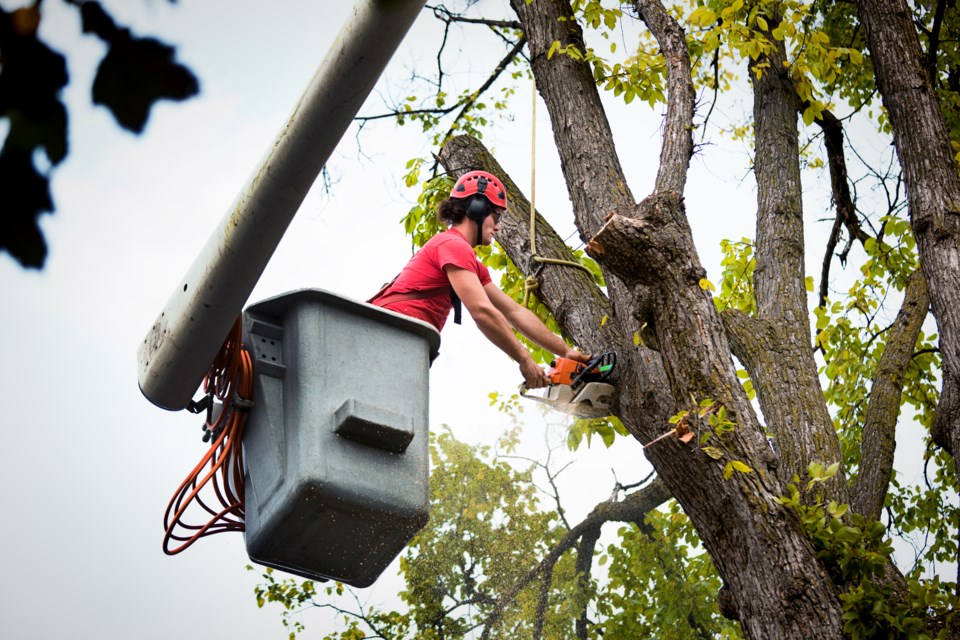It takes city hall roughly 30 years to complete one full pruning cycle of the community’s roughly 15,000 trees, but city council hopes extra employees can help improve overall forest management.
During its recent budget meeting, council voted 6-1 to let the parks and recreation department hire two permanent urban forestry crew employees for $139,850, with funding to come from the operating budget.
Coun. Dawn Luhning was opposed.
This addition will add 0.4 percentage points to the proposed municipal taxation increase for 2024.
These two employees will address emergent service requests and improve the pruning cycle, which should improve tree health and protect this roughly $100 million investment, said director Derek Blais.
The department has only a two-person crew, which causes challenges in maintaining proper trimming cycles and addressing hundreds of annual service calls, so four people — two two-person teams with certain responsibilities — should enhance response capabilities, reduce trimming times, enhance public safety and mitigate legal liabilities, he continued.
Year-to-date, the department has received 510 maintenance requests and addressed 373 — 73 per cent — of them.
“Proper maintenance of our urban forest involves activities such as tree planting, pruning, pest control and regular assessments to ensure the health and vitality of the trees,” Blais stated.
Parks and rec is completing a digital inventory that will provide data on the health, species, size, number and maintenance history of all city-owned trees, the director said.
The department currently has 6,661 trees inventoried, of which 522 — or eight per cent — are in poor health with a lifespan of under 10 years and will require removal and replacement. Meanwhile, 2,128 trees are in fair health with a lifespan of over 10 years but require maintenance to prevent further decline.
Blais noted his department aims to plant a new tree for each one it removes to sustain the urban forest. Ideally, the department would prune those new trees three years after planting and about four years later to reduce the risk of failure.
Dutch Elm Diseases (DED) is the most damaging problem, as cases have increased over the past five years. However, he noted that staff contains cases to roughly one per cent annually through a yearly basal spraying program. Unfortunately, Health Canada is phasing out this chemical and there are no available alternatives.
“This will put more pressure on us for pruning cycles and care for the trees,” Blais said.
The department regularly hires contractors to support its block pruning program and to trim boulevard trees on a block-by-block basis. With current resources, in-house pruning is primarily complaint-driven and prioritized based on risks to people and property.
Blais noted that this was a record year for complaints about trees covering stop signs, traffic signals and other important infrastructure.
Over the last three years, parks and rec has spent an average of $56,290 annually on its contracted pruning program, enabling the trimming of 301 trees a year, data shows. During the same period, city staff have pruned an average of 205 trees, for a total of 506 — and a pruning cycle of 30 years.
The department has projected that those numbers this year will be 200, 356, 556 and 27, respectively.
A pruning schedule of roughly seven years is the minimum arboriculturally acceptable cycle length since any longer and tree conditions decline, said Blais. Therefore, the second two-person crew should reduce the trimming cycle by seven years to 20 years.
Mayor Clive Tolley said Moose Jaw has a “wonderful urban forest” that makes it unique. Meanwhile, he has advocated for years for better maintenance and repair of trees — especially along boulevards —and for more plantings.
Even with two extra people, he noted that the trimming cycle would still be too long, leading to higher expenses — mostly due to storm damage — to maintain the existing forest. He thought it was worth trimming many trees to avoid further expenses.
Coun. Heather Eby thought this was a difficult project to approve but knew the department wouldn’t be able to accomplish anything without more people. She also expressed surprise at the 46 pages of requests the department accumulated this year.
“This is obviously something important to our citizens,” she added.
Coun. Crystal Froese said having only two employees means the city is reacting to complaints, cannot maintain the urban forest’s overall health and is not addressing safety concerns. That’s also why the department has accumulated so many pages of complaints.
Trees are something residents see regularly, compared to non-visible infrastructure items like cast iron pipes, said Coun. Doug Blanc. While he was also troubled about approving this, he believed many trees needed trimming after driving around the community.
No one likes tax increases, but council can only defer this problem for so long, said Coun. Jamey Logan. He pointed to the many safety complaints and wondered when the municipality became liable for trees blocking important signs.




